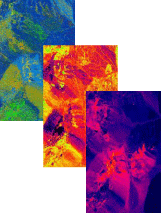Complex human-environment systems. Transformation of the earth's social and ecological systems is occurring at a rate and magnitude unparalleled in human experience. Many attendant challenges, such as feeding growing populations or dealing with global environmental change, are manifestations of complex human-environment systems. Dr. Manson advances knowledge in a variety of research areas, including interactions among agriculture, population, and institutions; and urban issues including disease, environmental, and residential mobility. The Ecological Society of America recognized this cholarship with the Sustainability Science Award for 'outstanding contributions to sustainability science.
Spatial Science. Spatial science examines spatial phenomena, processes, and patterns through technologies such as computer mapping and mathematical modeling. Spatial computing brings together data from an array of sensors, ranging from GPS units in mobile phones to satellite-based cameras, on a range of human and environmental systems. Dr. Manson ublishes extensively in this area with a focus on spatial big data and in methods arising from the complexity sciences, such as agent-based models and cellular automata.
Cyberinfrastructure and Big Data. Scholars interested in a wide array of social, natural, and human-environment questions face a dearth of detailed, multidecadal, global-scale data. In response to these data needs, Dr. Manson and colleagues conduct cyberinfrastructure for ‘gold standard’ research data on population, socioeconomics, health, and environment. Scientists increasingly use 'big data', or very large data sets and attendant analysis approaches, to understand an enormous array of phenomena, ranging from social networks on the internet to large scale deforestation.
National Historical Geographic Information System (NHGIS) is the nation's most comprehensive source for census data, geographic data, and metadata describing population characteristics of American regions, places, and neighborhoods from 1790 to the present. NHGIS is the largest publicly accessible population database in the world and is an essential component of the shared data infrastructure for population and health research. NHGIS is supported by:
- National Science Foundation Methodology, Measurement, and Statistics Program, Economics Program, Geography and Spatial Science Program, and Sociology Program (08/15/2018–07/31/2023). National Historical Geographic Information System (SES-1825768). S. M. Manson, , E. Wrigley-Field, C. Fitch, and J. P. Schroeder ($999,900).
- National Institutes of Health, Eunice Kennedy Shriver National Institute of Child Health and Human Development (08/15/2018–08/15/2023). National Spatiotemporal Population Research Infrastructure (2R01HD057929-11). S. M. Manson, D. Van Riper, J. P. Schroeder, and T. Kugler ($2,924,060).
- National Institutes of Health, Eunice Kennedy Shriver National Institute of Child Health and Human Development (09/01/2013–08/31/ 2018). National Spatiotemporal Population Research Infrastructure (2R01HD057929). S. M. Manson, S. Ruggles, J. Schroeder, D. Van Riper, W. Thomas ($3,020,552).
- National Science Foundation Methodology, Measurement, and Statistics Program, and Department of Justice, Bureau of Justice Statistics (08/15/2013–07/31/ 2018). National Historical Geographic Information System (SES-1324875). S. M. Manson, J. Adams, C. Fitch. K. Genadek, S. Ruggles ($869,999).
International Historical Geographic Information System (IHGIS) is the International Historical Geographic Information System, which provides data tables from population and housing censuses as well as agricultural censuses from around the world, along with corresponding GIS boundary files. Data from diverse published documents are provided in a standardized, ready-to-use structure with thorough, consistently formatted metadata.
- National Science Foundation Human Networks and Data Science (09/01/2021–08/31/2025). HNDS-I: From Stacks to Stats: Unlocking International Census Data from Print Volumes (BCS 2121891). S. M. Manson, S. Ruggles, E. Roberts, T. Kugler, and L Cleveland ($999,996).
IPUMS Terra integrates population and environmental data across disciplinary scientific domains, enabling research into dramatic transformations of human populations, the environment, and their interactions. IPUMS Terra was recently named one of GIS Geography's top 10 GIS data sources and featured in articles on GIS Geography and GIS Lounge. IPUMS Terra is supported by:
- National Science Foundation Sociology and Data Infrastructure Programs (09/01/17–02/28/22). RIDIR: IPUMS-Terra: Global Population and Agricultural Data (SMA-1738369). S. M. Manson, L. Cleveland, J. DeWaard, S. Ruggles, and L. Samberg ($1,452,537).
- National Institute of Child Health and Human Development, National Institutes of Health (09/01/2013–06/30/2018). Integrated Samples of Latin American Censuses,1960–2003 (2R01 HD044154-06). R. McCaa, D. Levison, S. M. Manson, S. Ruggles and M. Sobek. ($2,024,345).
- National Science Foundation (09/01/2011–12/31/2016). OCI: Terra Populus: A Global Population/Environment Data Network (0940818). S. Ruggles, V. Interrante, S. M. Manson, S. Shekhar, and J. Srivastava. ($7,998,550).
I-GUIDE, the Institute for Geospatial Understanding through an Integrative Discovery Environment (I-GUIDE) at the University of Illinois Urbana-Champaign (U of I) received $15-million in funding over five years as part of the National Science Foundation (NSF)’s Harnessing the Data Revolution program. This new national initiative enables geospatial data-driven scientific discovery to better understand the risks and impacts of climate change.
- National Science Foundation Office of Advanced Cyberinfrastructure (OAC) (10/01/2021–09/31/2026). HDR Institute: Geospatial Understanding through an Integrative Discovery Environment (OCS 2118329). S. Wang, PI; Manson is senior personal ($15,000,000). This project establishes the Institute for Geospatial Understanding through an Integrative Discovery Environment (I-GUIDE) that enables the harnessing of geospatial data for understanding interconnected interactions across diverse socioeconomic-environmental systems to enhance community resilience and environmental sustainability.
See the Human-Environment GIS site for more detail on research projects.
Papers and other products via these aggregators:

